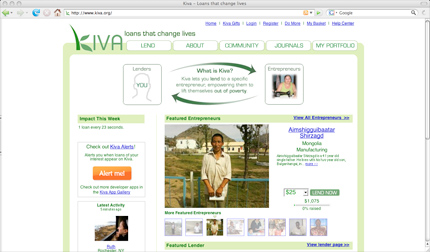
Kiva's website matches third-world entrepreneurs with individual lenders
During a 2004 trip to Africa, now-married couple Jessica Jackley and Matt Flannery observed three facts that drove them to found the first person-to-person micro-lending site Kiva.org: the Internet drives down communications costs; personal stories motivate us in ways that abstract “causes” can’t; and the poor are already scrappily entrepreneurial, motivated to help themselves. Founded in 2005, Kiva built on a 30-year-strong tradition of microfinance whose most public face might be 2006 Nobel Prize winner Muhammad Yunus. Kiva’s twist was to harness the internet to tap individual lenders. “Just like eBay brings buyers and sellers together, we’re the platform that connects people who need loan funds to people who would like to lend,” says Fiona Ramsey, spokeswoman for Kiva.
Here’s how Kiva works: An entrepreneur in Bolivia always sells out of her tamales at lunchtime at the local construction site. She would sell a lot more tamales if she could upgrade her transportation from a shoulder-bag to, say, a pushcart. She applies to a local micro-finance institution (Kiva has 103 “field partners” in 49 countries) for a loan. The field partner sets the loan’s terms and administers it day-to-day, often providing additional services like job training or childcare. Who actually provides the bucks? Enter Kiva: Each entrepreneur’s profile appears on his or her website, where individual lenders can donate to other individuals. According to Kiva’s statistics page, loans typically get funded in 50 hours. Kiva — the name is Swahili for “agreement” or “unity” — pays its overhead through optional donations from lenders.
Unlike charitable donations, Kiva funds are loans that are ultimately repaid more than 98 percent of the time; most Kiva lenders recycle funds back into another loan, literally giving them more bang for their buck. “On average we see the same 25 dollars loaned out four times, so it has the impact of 100 dollars,” Ramsey notes. Such efficiency helped Kiva win a 2009 INDEX Award for humanitarian design, in the Work category.
Kiva doesn’t take sides in the debate about whether microfinance should be run on a non-profit or for-profit basis, working with partners from both approaches. Although Ramsey acknowledges the potential for abuse, she notes that profit-seeking partners shouldn’t be written off as rapacious: Not only do many for-profit partners offer small-business services, “for-profit institutions drive toward greater efficiency, bringing interest rates down” across the region. Kiva also doesn’t take sides on micro-finance’s female bias; 83 percent of its partners’ entrepreneurs are women. A recent New York Times Magazine cover story supports what micro-finance experts have known all along: Much more than men, poor female entrepreneurs tend to use their money to improve the entire family’s nutrition, housing and education.
If anything, Kiva’s problem has been its outsize success. With every news profile comes a flood of new lenders, often outstripping available entrepreneurs. Lenders might be puzzled by a request to come back later when more entrepreneurs are added to the site. “The response is usually: What do you mean, there’s no more poor people?” laughs Ramsey. Not yet, although Kiva is applying all its hustle to get us there.
